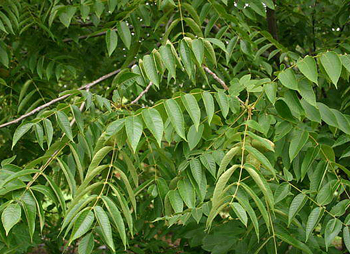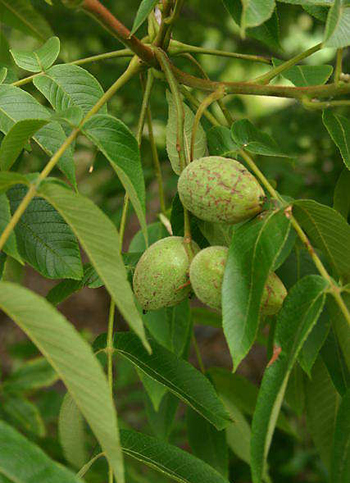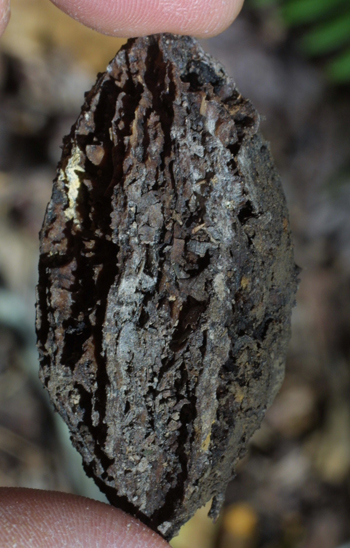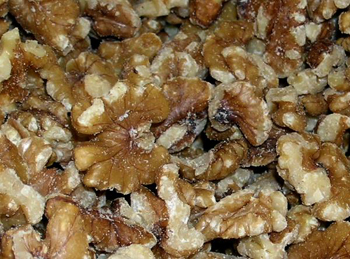Contents:
Common Names | Parts Usually Used | Plant(s) & Culture | Where Found | Medicinal Properties | Biochemical Information
Legends, Myths and Stories | Uses | Formulas or Dosages | Resource Links | Bibliography
Scientific Names

- Juglans cinerea L.
- Juglandaceae
- Walnut family
Common Names
- Butternut
- Lemon walnut
- Oil nut
- Oil nut bark
- Walnut
Parts Usually Used
Inner bark, nuts, nut oil, and leaves
Back to Top

Description of Plant(s) and Culture
Butternut is a native North American tree that grows to a height of 50-75 feet. Its branches spread wide from the trunk and are covered with smooth, gray bark. The leaves are alternate, large, and pinnate, with 7-8 pairs of serrate, oblong-lanceolate leaflets. Male and female flowers grow in separate catkins. The rough, deeply furrowed, fruit is an edible, pleasant-tasting, egg-shaped, kernel in a hard, dark nutshell.
Back to Top
Where Found
Found from New Brunswick to Georgia, westwards to the Dakotas and Arkansas. In rich woods.
Back to Top

Medicinal Properties
Anthelmintic, cathartic, fruit is tonic, leaves are alterative, bark is laxative, husks of nuts are vermifuge
Back to Top
Biochemical Information
Juglon (also called nucin or juglandic acid), essential fatty acids
Back to Top

Legends, Myths and Stories
The unripe, half formed fruits of Butternut, make fine pickles, so the old herbalists claim. The sap makes a fine sugar; the leaves, bark and unripe fruit make a dye that is chocolate-brown and was used by the South during the Civil War as a dye for soldiers’ uniforms. Often referred to as the butternut uniforms of the Confederacy.
Back to Top
Uses
Butternut has a soothing, tonic laxative particularly suited to chronic constipation. The bark or the unripe nut will expel worms, parasites, and is used for feverish colds and flu. Used for dysentery, diarrhea, and liver congestion. The leaves or green husks of the nuts taken as a tea is used in the treatment of eczema and other skin diseases.
Native Americans used the bark for rheumatism, headaches, toothaches, wounds to stop the bleeding, promote healing. Oil from the nuts is used for tapeworms, fungal infections. Juglone, a component, is antiseptic and herbicidal, some anti-tumor activity has also been reported. The quills or inner bark are potent laxatives that are safe to use during pregnancies.
Back to Top
Formulas or Dosages
Decoction: use 1 tsp. bark with 1 cup water. Take 1 cup a day, cold, a mouthful at a time.
Syrup: boil 1 lb. of bark in water. Evaporate the solution down to 1 pint. Add a lb. of sugar and boil until the desired consistency is reached. Take 1 tbsp. at a time.
Tincture: take 1-15 drops, 3 times a day.
Back to Top
Resource Links
Mayo Clinic – Cholesterol: Top 5 foods to lower your numbers
PubMed.gov: Antihypertriglyceridemic effect of walnut oil.
PubMed.gov: Blood cholesterol and walnut consumption: a cross-sectional survey in France.
Bibliography
![]() American Folk Medicine
American Folk Medicine, by Clarence Meyer, Meyerbooks, publisher, PO Box 427, Glenwood, Illinois 60425, 1973
![]() The Complete Medicinal Herbal
The Complete Medicinal Herbal, by Penelope Ody, Dorling Kindersley, Inc, 232 Madison Avenue, New York, NY 10016, First American Edition, copyright 1993
![]() Eastern/Central Medicinal Plants
Eastern/Central Medicinal Plants, by Steven Foster and James A. Duke., Houghton Mifflin Company, 215 Park Avenue South, New York, NY 10000
![]() The Herbalist Almanac
The Herbalist Almanac, by Clarence Meyer, Meyerbooks, publisher, PO Box 427, Glenwood, Illinois 60425, copyright 1988, fifth printing, 1994
![]() The Herb Book
The Herb Book, by John Lust, Bantam Books, 666 Fifth Avenue, New York, NY. copyright 1974.
 How Indians Use Wild Plants for Food, Medicine & Crafts
How Indians Use Wild Plants for Food, Medicine & Crafts, by Frances Densmore, Dover Publications, Inc., 180 Varick Street, New York, NY 10014, first printed by the United States Government Printing Office, Washington, in 1928, this Dover edition 1974
![]() Indian Herbalogy of North America
Indian Herbalogy of North America, by Alma R. Hutchens, Shambala Publications, Inc., Horticultural Hall, 300 Massachusetts Avenue, Boston, Massachusetts 02115, 1973
![]() The Nature Doctor: A Manual of Traditional and Complementary Medicine
The Nature Doctor: A Manual of Traditional and Complementary Medicine, by Dr. H.C.A. Vogel; Keats Publishing, Inc., 27 Pine Street (Box 876) New Canaan, CT. 06840-0876. Copyright Verlag A. Vogel, Teufen (AR) Switzerland 1952, 1991
![]() Planetary Herbology
Planetary Herbology, by Michael Tierra, C.A., N.D., O.M.D., Lotus Press, PO Box 325, Twin Lakes. WI 53181., Copyright 1988, published 1992
![]() The Yoga of Herbs: An Ayurvedic Guide to Herbal Medicine
The Yoga of Herbs: An Ayurvedic Guide to Herbal Medicine, by Dr. David Frawley & Dr. Vasant Lad, Lotus Press, Twin Lakes, Wisconsin, Second edition, 1988.
![]() Webster’s New World Dictionary
Webster’s New World Dictionary, Third College Edition, Victoria Neufeldt, Editor in Chief, New World Dictionaries: A Division of Simon & Schuster, Inc., 15 Columbus Circle, New York, NY 10023
 The Rodale Herb Book: How to Use, Grow, and Buy Nature’s Miracle Plants (An Organic gardening and farming book)
The Rodale Herb Book: How to Use, Grow, and Buy Nature’s Miracle Plants (An Organic gardening and farming book), edited by William H. Hylton, Rodale Press, Inc. Emmaus, PA, 18049., 1974
